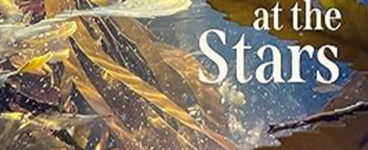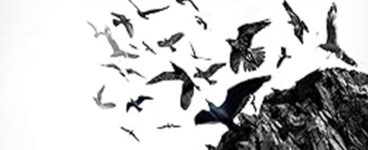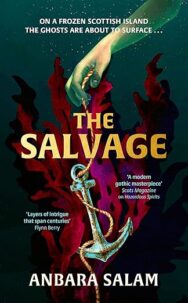‘The first dive into a ship is an otherworldly experience. It’s travelling into a moment that has been paused in time.’
The Salvage, Anbara Salam’s second novel, is an entertaining gothic tale of supernatural mystery and claustrophobic island living. The novel sees maritime archaeologist, Marta Koury, travel up to the north of Scotland to investigate a shipwreck belonging to an aristocratic family. This extract describes her first dive into the wreckage.
The Salvage
By Anbara Salam
Published by Baskerville
The first dive into a ship is an otherworldly experience. It’s travelling into a moment that has been paused in time. When Jenine and I were young, we used to play a game where we peeked through other people’s windows and made up stories about their lives. It was a winter game, best played after the brooding Glasgow sunset, when strangers’ front rooms would be lit up by the fire, tea-kettles whistling from back kitchens. The boards of HMS Deliverance are lacy with algae, and I trace my fingers over knots in the wood. It gives me the same kind of thrill I felt back then, as the unseen observer of someone else’s world. Like I have become both invisible and all-powerful. Being the first diver to visit the ship after her relocation means that I’m exploring a place almost nobody has been in over a hundred years, since she sank. I have her all to myself.
Inside the passage, the lips of water beyond my torchlight are coal black, stippled with freckles of sediment. Slowly, I ease myself along the narrow corridor that leads to the crew quarters. The cabins along the right-hand side are frozen in Victorian grandeur. They look exactly as they must have in 1849 when the boat last left Port Mary Harbour: wooden panelling, narrow bunks built into the walls. I expected there would be breakage from when the ship was towed back here, but she was made for movement: furniture nailed to the walls, drafting pens fixed to writing desks. I take photographs of the crew quarters, the flash glinting on shaving mirrors shrouded in webs of algae. I’ve never seen a site like this before – it seems almost staged in its completeness, like a doll’s house. Through the silt I spot an ivory-handled clothes brush and a tin spectacle case tucked into the rail of the first officer’s bunk. Lord and Lady Purdie will have their pick of trophies for their museum. After taking pictures in the next three rooms, I kick gently down to the far end of the starboard side. A copper-coloured pollock has slipped in from the kelp on the seabed and darts in startled zigzags as I approach the reason for my trip to Cairnroch Island: Captain Purdie’s bunk.
The door is sticking to the floorboards, and I deliberate for a moment before sliding my knife through the algae and dragging open the door, a fog of silt seeping into the water. I float against the ceiling of the passage until it’s settled enough for me to see my own hands again, and pull myself through into the room. The skeletal remains of Captain James Purdie appear in the frame of torchlight. Curled on the bottom bunk, his knees are drawn to his chest, wisps of hair drifting softly around his skull. His skeleton is well preserved, his bones dappled with gooey-looking sediment. Nestled under the remains of Purdie’s hands is a chunky golden ring – unusual for a Calvinist of this era, but perhaps it was a guild gift. I have to focus at close range to take a photograph, illuminating the faint outline of a barque engraved on the bezel. The Purdies will lose their minds over the ring – there couldn’t be a more perfect museum showpiece. Through the speckles of silt I peer through the doors of a glass-fronted cabinet, which contains a pair of bone snow goggles, a horn comb and a toothbrush, the bristles still intact. There is no porthole, but dents in the wall mark where nails must once have held up maps or schedules, maybe photographs from home, and slotted into a niche in the wall is a small gilt mirror. On the table next to Captain Purdie’s bunk is what looks like a copper coin, a fringe of glutinous seaweed smothering it to the surface of the wood. The discovery report recorded that the top drawer of the desk contains the provisioner’s ledger and the captain’s expedition journal, but the Danish team who found the ship were pessimistic about the likelihood of the books surviving the tow. The drawer has become gummed with seaweed, and I carefully drag my penknife through the fronds, praying I haven’t accidentally cut the material. When I prise open the drawer, the two leatherbound books inside seem to have held up much better than anticipated. Gingerly, I open the books and take photos at random to send back to Sophie, the textual expert at the museum in Edinburgh, for review. The captain’s diary contains preruled boxes for recording the latitude and longitude, as well as wind speeds and temperature. But I can’t make out the writing – visibility is too poor, and deciphering handwriting isn’t my strong suit in any case.
Swimming away from Captain Purdie’s remains, I squeeze through the passageway into the galley kitchen, where two metal spoons still hang from pegs on the wall. There is a horn cup engraved with Captain Purdie’s initials attached by a snap hook above the grate. It must have been his personal drinking vessel. I haven’t seen this type of fixture before; it’s a clever little grooved latch to stop items from falling during bad weather, and I take a couple of extra photographs. The pantry is stacked with corroding tins and stoneware jugs nailed into position with wooden dowels. It’s odd the crew would have left this many tins here before abandoning the ship, but I suppose they must have taken the dried pemmican with them. Maybe one day their remains will also be discovered. I wonder if Lord and Lady Purdie will pay for their repatriation, too, or if their generosity only stretches to their ancestors.
My regulator glitches; it hiccups with a start and I brace myself in the corner of the room. Don’t panic, I say to myself, release the valve, and it cocks back again. For a moment, I give myself permission to miss Alex, knowing that we could always rely on each other during a dive, if not above water. On the other side of the kitchen is the saloon, the only space on the ship large enough for group meals or socialising. The walls of the saloon curve inwards, and it feels smaller than I’d expected, silt gently coasting in the water like snowfall. It must have been claustrophobic for the crewmates to spend the dark Arctic winter cooped up in here while they planned their escape across the ice. The table riveted to the floor has gouges cut into it, someone marking down time, measuring wins or losses. As I take a picture of the grooves, a cupboard door on the far side under the porthole smacks open. I jump and the circle of torchlight swings to the ceiling. The bubble of my laughter echoes in my mouthpiece. I right the torch. The storage cupboard is only knee-high and set at an angle with a latch to prevent it from knocking open on rolling seas. In my surprise, I’ve unsettled the sediment and it is rippling in creamy ribbons that fill the room, like ash. It’s hard to take photos in such poor conditions, so I lever myself against the table to swim back the other way. As I begin to pull myself from the saloon, a flicker of movement behind me catches my eye. The cupboard door is closing again. Slowly, this time. I must have created an eddy of pressure. Or it’s a fish, knocking against the wood. I blink back into the room through the ripples of silt, raising my camera.
And there, underneath the window, a man is crouching.
The Salvage by Anbara Salam is published by Baskerville, priced £18.99.
ALSO IN THIS ISSUE

 Looking Down at the Stars by Christina Riley
Looking Down at the Stars by Christina Riley
‘To say, “I want you to see this” for no reason other than the belief that it will bring pleasure or …

 Bluff: A Q & A with Francine Toon
Bluff: A Q & A with Francine Toon
‘I think we all have that one friend we lost touch with from school. I wanted to explore the idea of …













